So, season 2 of Adventure Time.
Looking at the original air dates, the season boundary seems rather arbitrary at this point. The last episode of season 1 aired on September 27, 2010, and the first episode of season 2 on October 11, 2010. They only skipped a week!
I don’t really know how to interpret TV ratings numbers, but according to the people who estimate such things, about 2 million people were watching Adventure Time when it aired at this point, more or less the same as Season 1. The numbers appear to rise to a peak of about 3.5 million around season 5, and then steadily decline (perhaps as much because the internet happened as because people weren’t watching the show anymore). Still, 2 million sounds like a pretty big number - no doubt the execs at Cartoon Network had realised they’d found some pretty sweet capital here.
The other thing I notice on this list is… this is the season where Rebecca Sugar’s name appears among the list of writers and storyboarders. Apparently she began as a storyboard revisionist, then became a storyboard artist (before of course ultimately getting her own show in Steven Universe… am I gonna liveblog that? no)
Season 2
Episode 1: It Came from the Nightosphere
The season starts out with, it’s gotta be said, a fucking brilliant episode. I think the showrunners thought so too, because Marceline’s dad (later named Hunson Aberdeer) becomes a recurring character.
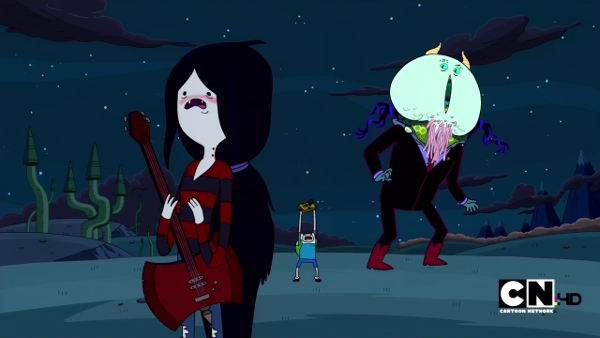
I really like how they play off the tension of Finn and Marceline’s completely different perceptions and approaches to the situation here, but also, especially, the wonderful imagery they used for Marceline’s dad in his final, monstrous form. Adventure Time does really well with squishy goo monsters, transparent sacs, fronds etc. - their ‘dragons’ are unique as hell - and it’s on full display here. They have a very neat balance of hyper-detailed weird gross stuff and extremely simplified figures.
The ‘why did you eat my fries?’ thing is probably intended here to be a deliberately nonsensical, minor issue; later on they will try and retcon that as they flesh out the relationship between Marceline and her dad.
Episode 2: The Eyes
A ‘something weird happens and Finn and Jake respond’ episode, but one that works really, really well. The horse, god… the bit with the blindfold! It’s like the elephant joke sequence, constantly building on itself and iterating. We know the horse will always menace Finn and Jake, but the ever more roundabout ways it does so, and the episode’s rhythm… what a good sequence, honestly.
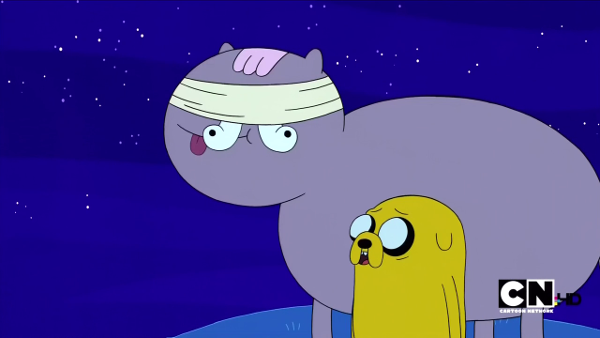
The ending is, eh. Of course they would have to resolve the tension (‘why the horse, will Finn and Jake ever get to sleep’) somehow. ‘It’s the Ice King trying to understand friendship’ works well enough, and the ending is actually quite cute.
I always have the problem that when an episode is really good, I struggle to actually write anything about it, because a list of jokes I found funny isn’t very interesting commentary! While I was working on this, I joked that I’d find really strained leftist readings of every episode: “this episode is about the difference between form (a weird horse) and content (the Ice King)”. In truth, that’s not really a good application of the ‘form vs content’ distinction. I’m not really going to do that (I actually find bullshitting pretty hard…) but if you like that sort of thing, get ready for episode 14.
Episode 3: Loyalty to the King
What a strong start to the season the last two episodes were! “This is gonna be a great season! Can’t wait to see where they go next!”
Where they go next is a disaster, honestly.
The Ice King shaves his beard. Having done so, he starts getting fawned over by dozens of princesses who want to get with the ‘Nice King’ despite his obviously callous, misogynist behaviour. Finn and Jake also swear to serve the ‘Nice King’ as knights for… some reason… but as Finn becomes increasingly uncomfortable with being expected to treat women as sex objects, and eventually works out that the ‘Nice King’ is the Ice King and reveals the ruse.
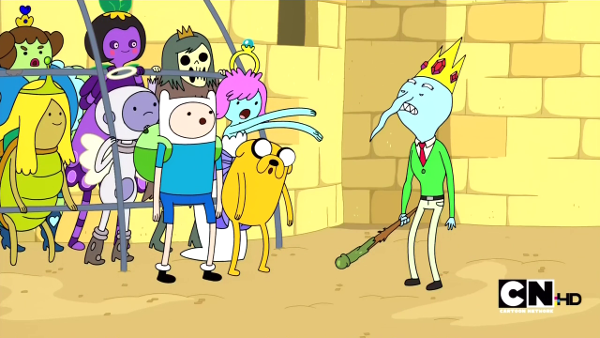
So, “don’t treat women as objects, boys”. Or something. Not a bad message, obviously. But where it falls down, just catastrophically, is that all the women in this episode are turned by the demands of plot into being just as disposable and vapid as the (N)Ice King believes them to be, and Finn and Jake are put in the role of rescuers - to the point of having to fight their way through the foolish princesses in order to glue the Ice King’s beard back on and reveal his true nature.
It’s so bad! It’s probably the worst episode of the show so far - not just mediocre and unfunny but misogynist at its core. In this episode, women lack autonomy and will quite literally gladly accept being thrown in jail to get with a ‘pretty’ jerk. Who the fuck wrote this? Kent Osborne, apparently, who also worked on the last episode, and in the last season, My Two Favourite People, and When The Wedding Bells Thaw. The latter two of which also focus on het gender relations, squarely from the perspective of men, with women reduced mostly to tools to further the plot. Lady Rainicorn, at least, doesn’t suffer the same level of character assassination, but her ep still had that whole Tiffany gag…
All right, Kent! I’m watching you. You’re back up in Episode 10 this season, which has the unpromising title of “To Cut a Woman’s Hair”.
Episode 4: Blood Under the Skin
This episode is also… not great. It does introduce a fan favourite character, Choose Goose. Anyway, the plot of this episode is: Finn gets bullied by some knights (uh, OK?) for not having sufficiently ‘click-click’ (make a clicking noise with your mouth lol) armour, so he goes on a quest to get some, which requires him to undergo various kinds of vaguely sexual humiliation, from seeing a bunch of old people naked by accident (really?) to being expected to pick up a ball with his buttocks (really?) to, uh… forced femme?
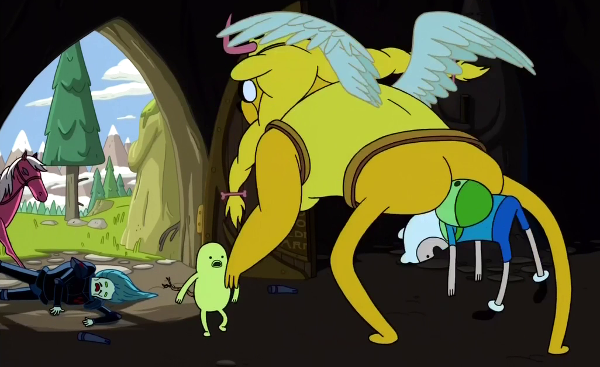
Give in to the forced femme, Finn… but honestly this episode was just uncomfortable.
Episode 5: Storytelling
Jake gets ill so Finn has to tell him a story. It has to be a real story for reasons, so Finn goes off to build a story around a checklist. Naturally his vague-at-best understanding leads him to treat people in a really dickish way, but it all works out for the best and in the end, creates the story after all, just not as he imagined.
It’s a cute conceit. The episode is… kinda average overall.
Notably, this introduces Mr. Fox, here just one of a lot of forest animals. Mr. Fox will become a much more prominent character!
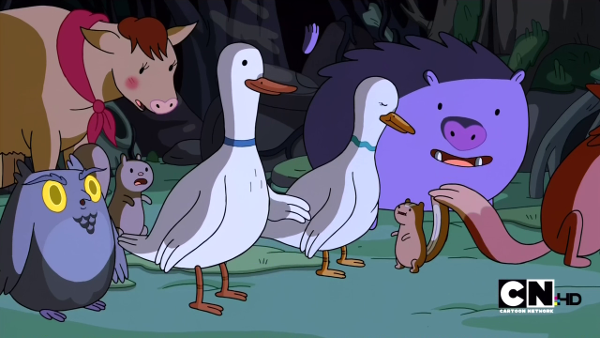
There’s something to say about how they code gender among the forest animals. In Adventure Time’s super-stylised art style, it’s mostly through voices, eyelashes, and minor feminising touches like a wavy colar or visible lips. Nearly every animal in the forest is in a hterosexual, nuclear family, grumble grumble…
Come to think of it, how is it that there are so few of each kind of animal that a name like ‘Mr. Fox’ or ‘Mr. Goose’ could be an unambiguous referent? Did the apocalyptic event that left Finn as the only human also wipe out all the foxes, geese etc. down to only one or two? There are exceptions to this naming scheme: instead of Ms. Goose, we have ‘Boobafina’… the answer is of course, it’s a cartoon for kids and I’m overthinking it.
Episode 6: Slow Love
In this episode, we continue the focus on heterosexuality with Finn and Jake being called to help an incel ‘snail’. (OK, they don’t use the word ‘incel’, but the rhetorical similarity is uncanny). The guy is pushy, smashes up Finn and Jake’s house, and overall seems to have no redeeming qualities, until the boys teach him to beatbox while swinging swords, at which point dozens of snail women flock to him and Jake has to result to injuring him with salt to get him to give the stolen piece of house back.
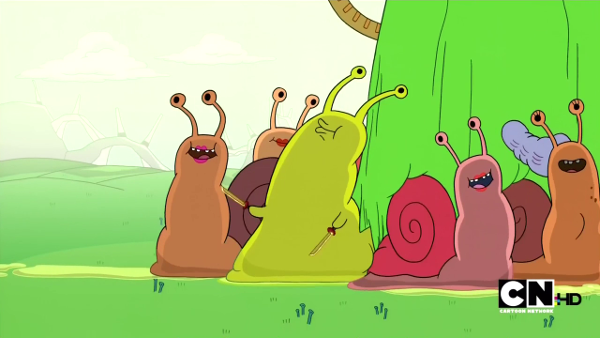
At this point, it’s revealed he’s actually a slug, not a snail - but fortunately one of the ‘snail’ women is also actually a slug, and they start making out in front of Finn and Jake’s house, which the boys agree is gross.
So in short: another episode where women are entirely props and accessories, and male characters get to have internal lives and character development. It’s wacky or something, I guess.
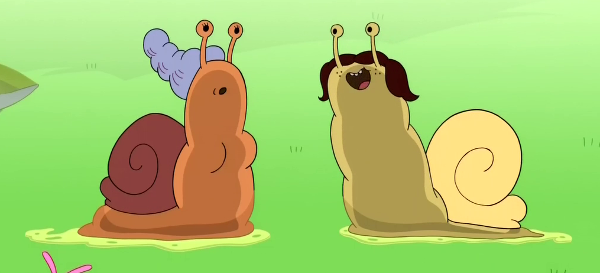
This episode has snails with boobs, lipstick and eyelashes. I think the absurdity is kind of the point, but honestly. At some point you need to stop making fun of a bad trend and show an alternative, you know.
Episode 7: Power Animal
Finn gets kidnapped by gnomes who want to use him as a power source to invert the world, while Jake attempts to deal with his lack of focus and commitment. Ultimately this is what leads to him rescuing Finn.
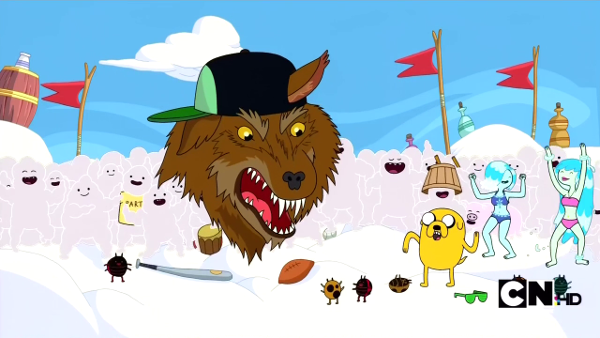
This is the first episode to feature the ‘Party God’, a floating wolf head in a snapback. Adventure Time is really obsessed with ‘parties’ at this stage in the narrative, though it doesn’t do a whole lot to actually make them seem appealing.
There’s not a huge amount to say about this episode. The Party God is at this point voiced by Dee Bradley Baker, who has voiced animal characters in a whole bunch of cartoons, e.g. Appa, Momo and Lion? That’s a thing. His main role in AT is Cinnamon Bun.
Episode 8: Crystals Have Power
The cool thing about this episode is that we get Tree Trunks back.
This is the first episode focused on Jake’s dysfunctional relationship with his family! We’ve seen Jake’s parents a couple of times, e.g. in Memories of Boom Boom Mountain, but this I think is the first time we get to see more about what Jake feels about them. ‘Bad dads’ seems to be a theme in this season (c.f. Marceline) and of the show in general (as we’ll see when Finn’s dad shows up, much much later).
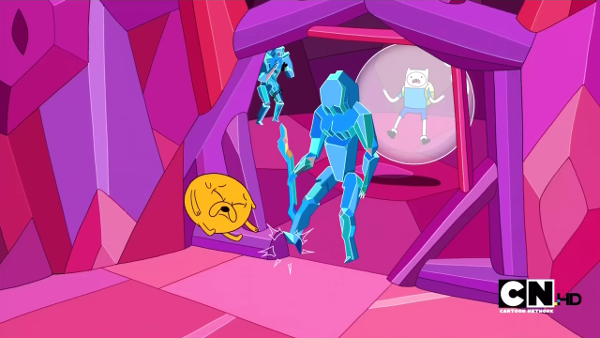
In this case, Jake accidentally hurts Finn, and this reminds him of his dad praising him for accidentally hurting his brother. If this is supposed to be about abuse, it’s uncomfortably flippant; if it’s not, I’m not sure what it’s saying. Anyway, Jake’s newfound pacifism (didn’t we already have this plot in His Hero?) proves troublesome when Finn is kidnapped by crystal soldiers from another dimension, and Jake can’t get them to give him back just by asking or vaguely threatening the guards without credibility.
The resolution is that Jake’s dad was actually saying Jake would hurt ‘everybody who is evil’. This is lucky, because it turns out eating the crystal apple made Tree Trunks gain magic powers and become ‘Quartzion, ruler of the crystal men’, and, corrupted by their power, attempt to turn Finn into her ‘sexy crystal king’ (even though he’s like what, 12 at this point?). It’s like the Standard Ice King Plot but backwards. PG sexual violence is just what semi-villains do in Adventure Time, idek?
With Jake’s ‘biz’ resolved, he punches the apple out of Tree Trunks and they return home so that Tree Trunks can become a recurring character like the fans want.
Episode 9: The Other Tarts
This episode’s pretty good actually - notwithstanding entirely unnecessary disablism.
Princess Bubblegum tasks Finn and Jake with transporting a set of ‘royal tarts’ to the sacred ‘annual backrubbing ceremony’ - at risk of her own execution! Finn comes up with an elaborate ruse which backfires spectacularly, leaving him and Jake stranded in the desert sans tarts, while Cinnamon Bun takes a set of poisoned decoy buns along a safe ‘royal tart path’. (This of course comes with mean-spirited jokes at the expense of the ‘half-baked’ Cinnamon Bun.)
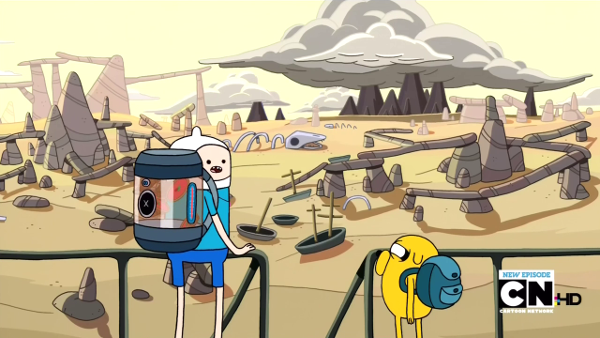
I enjoyed all the jokes of Finn’s elaborate justifications for doing the worst possible thing at every juncture. Anyway, in fact, PB is not at pain of execution; Finn and Jake were so incompetent they pulled some kind of mobius double reacharound and Cinnamon Bun had the real tarts all along; and the blind and ‘mad’ Royal Tart Toter arrives at the gathering and makes everyone uncomfortable by acting like random animals are tarts.
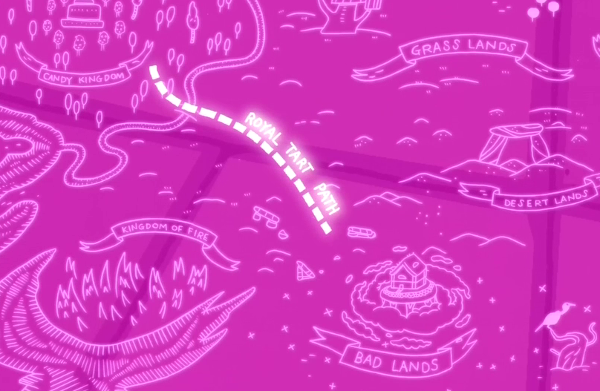
Episode 10: To Cut a Woman’s Hair
In this season it seems like every fun episode has to be balanced by an excruciating one. Which are, rather frequently, written by Kent Osborne. Oh yes, that fucker’s back.
In this one, Finn and Jake are menaced by an ugly (and as Jake suggests and is implicitly confirmed, therefore evil) Forest Witch, who demands that they acquire princess hair to cover her bald spot or she’ll absorb Jake into her butt. Yeah, eesh. This is an angle to forcing Finn to start confronting his anxiety over romance; he eventually takes PB on a very awkward ‘date’ which we can read as her humouring him, I guess.
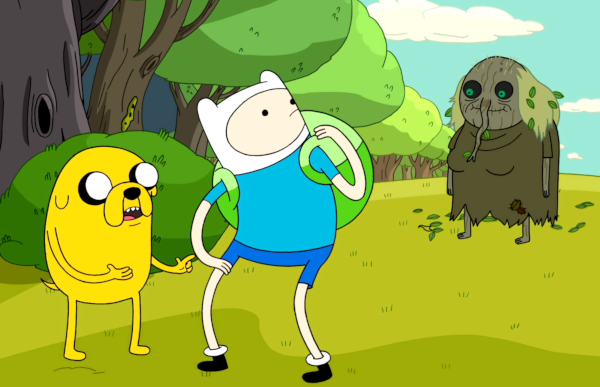
The resolution is that she rejects the bubblegum ‘hair’ that Finn got from PB (and eats it!) so Finn says she’d be ugly even with hair, and she relents.
The number of female characters whose arcs don’t revolve entirely around their relationship with a male character remains at, what, just Marceline?
This is the first episode to reveal Finn’s incredible flowing blonde locks, which he donates to the Forest Witch in lieu of princess hair - only to find she’s still evil. I guess it grows back fast!
Episode 11: The Chamber of Frozen Blades
In this episode, Finn and Jake are obsessed with ninjas for some reason. They found out the Ice King is too, and smash his house up with techniques of ‘Friojitsu’ described in a manual in his house. Meanwhile, the Ice King attempts to kidnap Doctor Princess - not actually a princess, her surname is just Princess! - and Gunter lays an egg which hatches into a cat!? This episode is something…
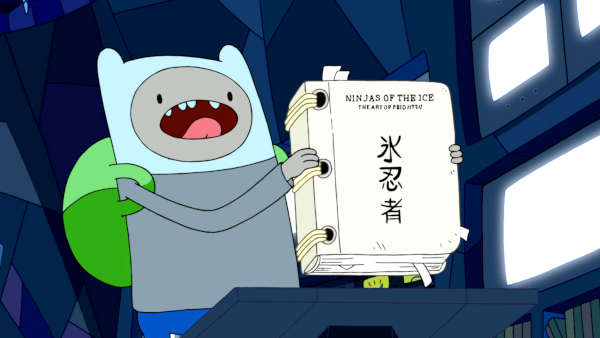
Anyway, it’s weeb time, so let’s think about the Japanese terms. The kanji on the cover of the ice manual reads 氷忍者 - 氷 is the kanji for ice, and 忍者 is a compound meaning ninja. Not sure if 氷 takes the on’yomi reading (if it’s one big jukugo word) so you’d have ひょうにんじゃ (hyouninja) or if it’s two words, so you’d have the kun’yomi reading and get こおりにんじゃ (koorininja). I did a search for 氷忍者 and I found Japanese ice skating videos, so it does seem to be something Japanese people might actually say; tentatively there’s more evidence for こおりにんじゃ. As for ‘friojitzu’ - ‘frio’ doesn’t really fit the Japanese syllabary so it’s probably just off ‘freeze’. I wonder how they localised this episode in Japan?
This episode reminds me of an episode of Planetes, in which the Japanese protagonists run into some westerners who are obsessed with pretending to be ninjas. Ultimately the Planetes episode settles on considering them mostly harmless dorks. Adventure Time’s take is inevitably a bit shallower lol
Episode 12: Her Parents
Here we introduce Lady Rainicorn’s parents, and get some backstory on dogs and rainicorns that will just… never come up again?
We knew already that the Rainicorns, for some reason, speak Korean. Here, in order to make an awkward social event, we find out that there was once a devastating war between rainicorns and dogs(!), so Jake decides to pretend to be a rainicorn to avoid alienating Lady’s parents (helped by the fact that both have very limited vision). This involves increasing pain and humiliation for Finn, culminating in the parents attempting to eat him, at which point Jake finally gives up the ruse. Naturally, it’s fine - a dog saved her dad in the war so they actually love dogs. Then they go and eat a soy substitute for human meat that, they claim, tastes just like the real thing. Apparently it’s delicious!
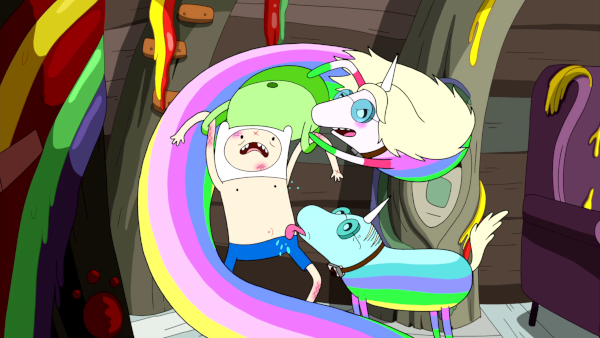
The ‘soy human’ bit was kind of funny, but most of the ~wacky~ stuff in this episode felt strained, ‘trying too hard’. Lady’s parents feel less like characters from whom the humour can come naturally, and more a bunch of ‘wacky foreigner’ jokes stapled together. Like, why name the traditional rainicorn game some mash of nonsense syllables and not just, something in Korean? Not to mention like, given that there’s all sorts of nasty stereotypes about Asian people eating weird things, I feel kinda uncomfortable with the whole cannibalism subplot.
Really, for most of this episode, I was waiting for the other shoe to drop - that the parents were playing a prank on Finn or something - but no, apparently that’s just what Rainicorns are like.
Episode 13: The Pods
Stop me if you’ve heard this one before: Finn and Jake encounter some strange magic person. They get embroiled in wacky events. A village we’ve never seen before is threatened, but they contain the threat they accidentally released.
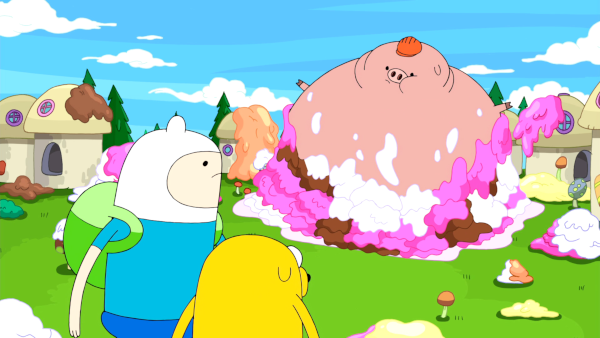
So Finn and Jake get some magic beans from a gnome knight, two good and one evil, which turn out to produce pods containing various things (pigs in costumes, magic wands, ice cream); the piglets turn out to be the evil ones, but they’re weak to ice cream. None of these events are ever mentioned again.
The best that can be said is that, for a Kent Osborne episode, this avoids the misogyny.
Episode 14: The Silent King
This episode is about Hobbes’s Leviathan.
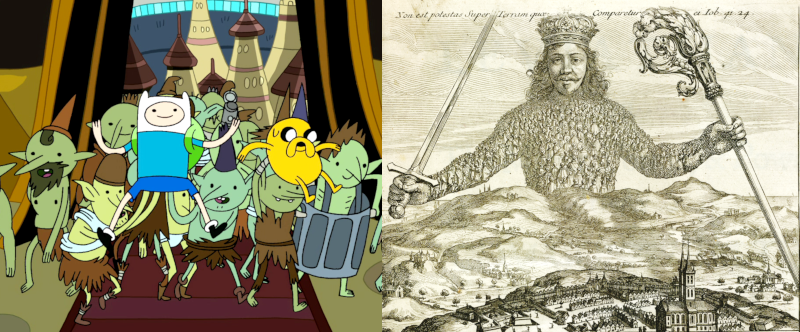
No, hear me out!
Finn and Jake oust an evil king from a goblin nation. The goblins ask Finn to be their king - and when he refuses, they start a riot, attacking each other, self-harming and other such things. So Finn steps in ‘to save them from themselves’.
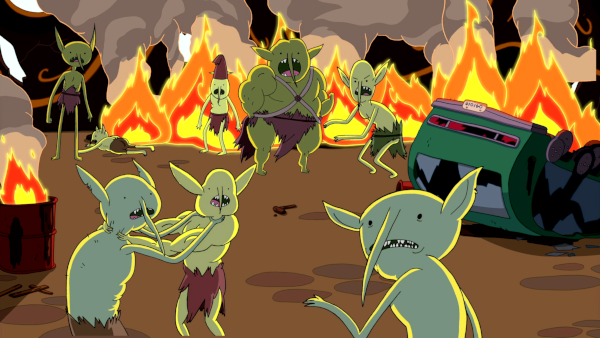
Compare Hobbes:
ostendo primo conditionem hominum extra societatem civilem, quam conditionem appellare liceat statum naturæ, aliam non esse quam bellum omnium contra omnes; atque in eo bello jus esse omnibus in omnia.
I demonstrate, in the first place, that the state of men without civil society (which state we may properly call the state of nature) is nothing else but a mere war of all against all; and in that war all men have equal right unto all things.
or later
Hereby it is manifest that during the time men live without a common Power to keep them all in awe, they are in that condition which is called War; and such a war as is of every man against every man.
Jake says Finn should have a queen, and then volunteers. I know it’s like, a man in a dress joke on some level, but I support this gay subtext becoming gay text.
We need a conflict, so Finn soon discovers that his authority is not quite absolute: there is a long list of ‘royal rules’ that he must follow. While these royal rules are more about silly things like ‘the king may not brush his own teeth’ or ‘the king may not cut his own food’, this reflects an ancient debate about what, if anything, should constrain the power of the King - whether they have a Divine Right to rule as they will, or if their mandate might be withdrawn if they fail to live up to their responsibilities. For Kings, of course, they want as much divine right as they can get away with. This theory became cemented by James VI of Scotland around 1597-98 about 50 years before Hobbes sought a secular justification for monarchy during the English Civil War.
In this case, every time Finn breaks a rule, the Goblins immediately offer themselves up for ‘spanking’, suggesting Finn is just as cruel as the prior king. Finn starts to realise the goblin society functions perfectly well with a pure figurehead King - in fact this becomes literal, as Finn finds that he can be replaced with a statue and leave the Goblin Kingdom behind.
So this episode does not so much reject the premise of Hobbes’s Leviathan - that an all powerful monarch is necessary for a harmonious society - but does then go on to say that it’s not just unnecessary but actually kind of harmful for the monarch to actually do anything! Instead, the function of the monarch can be found instead in the social relations themselves, codified in the ‘royal rules’.
What is this ‘monarch’, that cannot act except as governed by a particular logic, and arises not from a particular individual’s actions but from the totality of social relations? Perhaps this isn’t so very far from Hobbes - certainly, later writers, such as Perlman, have taken Hobbes’s word ‘leviathan’ and turned it on its head as a vast evil force structuring history.
Jackie pointed out that in medieval Ireland prior to the English conquest, there was a complicated system of federal authority, with between five and nine kingdoms each ruled by a king. In the legal fiction, these kings were all subject to a presumed High King - but for much of history, this High King was mostly a ceremonial title, and in practice, the nominal High Kings - whose claims were disputed up until the very last one! - ruled over just their own kingdoms. But despite not actually excercising authority, the nominal existence of these High Kings helped justify the social order. (Feel free to dispute my vague understanding if you actually know about this period of history!)
But perhaps we could narrow it to something more specific. In our present society, the logic of capital, of value, is what rules. Sure enough, society becomes divided into bourgeois and proletariat, but on a more fundamental level, the way we relate to each other is subsumed to this structure by forces more inexorable than the will of individual capitalists. The capitalists, themselves, are compelled to follow the logic of the market, the relentless drive towards accumulation, or find themselves shut out from the process and their role taken up by more willing capitalists. There is a quote from the Marxian economist Michael Heinrich that I like on this topic:
If the capitalist merely executes the logic of capital, then it is not he, but rather capital, self-valorizing capital, that is the “subject” of the process. Marx refers to capital in this regard as the “automatic subject,” a phrase that makes the paradox clear: on the one hand, capital is an automaton, something lifeless, but on the other, as the “subject,” it is the determining agent of the whole process.
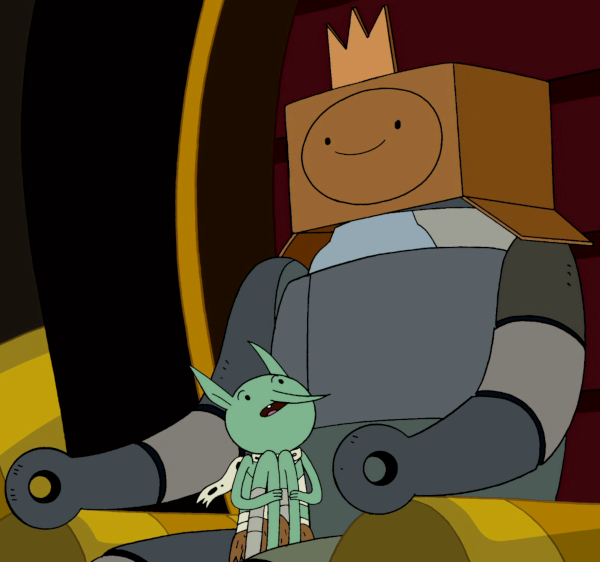
How far can we take this episode’s ‘Royal Rules’ for a metaphor for capital? Probably not very far, but bear with me here, I’m having fun. When Finn disobeys the Rules - which he finds nonsensical and alien, and which force him to participate in certain social processes just to survive - the goblins immediately panic and lie down for ‘punishment’ they imagine will come. Perhaps this can be read as reflecting the belief that capitalism is freedom, and the alternative is either the Hobbesian state of nature, or tyranny and absolute punishment. And yet, to the viewer, the Goblins’ belief in the necessity of these nonsensical rules is clearly irrational, and Finn is the understandable one.
Of course, science fiction authors have gotten a lot of mileage about imagining how strange our society would look to a carefully constructed alien Other who can call the things the author dislikes nonsensical and primitive. Perhaps we can see this as a more obligue, and broader-ranging, critique along similar lines…
Is the episode really saying this ‘Silent King’ is a good thing? Initially I read the episode as endorsing this idea, but on reflection I think it’s more ambivalent. Like many things in Adventure Time, it’s hard to tell just how seriously to take it. After all, it’s easy to dismiss the goblins as just one more wacky village…
Episode 15: The Real You
This episode is essentially there to develop the relationship between Finn and Princess Bubblegum, although PB’s interest in Finn seems almost more scientific curiosity than anything romantic.
She invites Finn to present at a scientific conference, and Finn becomes convinced he must make himself smarter to talk to these distinguished scientists. He finds his salvation in the returning Choose Goose, who gives Finn the ‘glasses of Nerdicon’.
As Finn puts on the glasses, we get a version of the famous ‘powers of ten’ zoom, which apparently establishes that the Adventure Time physics is recursive. Actually, if the last episode review was self-indulgent Marx wank, let’s take this opportunity to babble about physics. (Do you regret clicking this link now?)
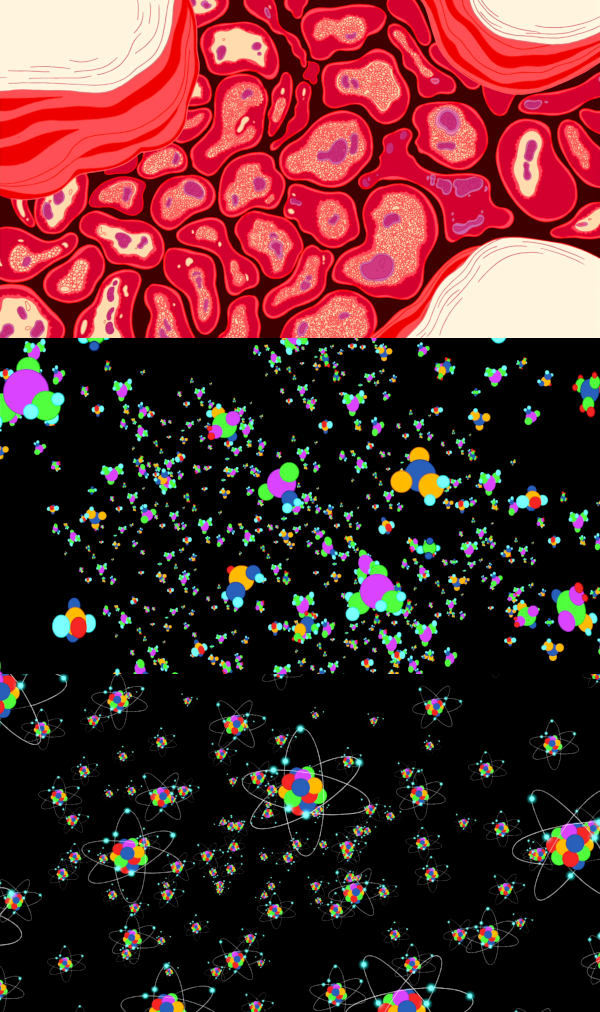
First, we see Finn’s skin cells (rather magnified in size). Flying between cells, we the layer of cells beneath, then a swarm of molecules… and then things get weird. Inside a single molecule, we find a universe of individual atoms, portrayed in the old never-actually-accepted-by-physicists style where three electrons orbit the nucleus in three different planes. And then we zoom in further, and we’re zooming in on galaxies, and further still, onto Ooo and on Finn himself.
‘As above, so below’ taken rather far! Or as Finn puts it, ‘everything small’s just a small version of something big!’ What implications would this have?
Let’s first go over why, in real world physics, everything small is not just a small version of something big.
It’s true that, in investigating the atom, the fact that Coulomb’s law of attraction between charges took the same form (indeed, was directly inspired by) Newton’s law of attraction between masses. But the idea that electrons orbit like planets is untenable, because the symmetry of the electromagnetic field is different than that of Newtonian gravity. Less abstractly: magnetic fields are a thing. Because of that, a charge that’s being accelerated - such as an electron orbiting an atom - radiates energy away, losing kinetic energy. This would cause orbiting electrons to spiral into the centre of the nucleus almost instantly.
This conundrum was one of the problems that led to the development of quantum physics at the beginning of the 20th century!
It turns out that
- firstly, electrons are delocalised, taking on both particle- and wave-like properties
- as a result, there are only certain quantum states (called orbitals in chemistry) that an electron can occupy in an atom! there is a ladder of energy levels, and the electron ‘wants’ to sit in the lowest one, and jumps between them by radiating photons of light at a particular frequency
- moreover, electrons are a kind of particle called fermions, which have a particular rule for what happens if you swap two electrons in a quantum state (the details of which would take a bit too long to explain…)
- the upshot is the Pauli exclusion principle, which says that you can’t have two electrons in the same quantum state! When you take into account spin as well as the electron’s position wavefunction, you find each orbital can contain at most two electrons.
- this means that electrons fill up the orbitals, starting with the lowest energy level (called the 1s orbital) and working their way up through the energy levels! And this, in turn, gives rise to chemistry.
So, electrons are not all that much like planets, even if they were thought to be at first glance. But there are similarities, because certain physical principles, such as symmetry and the dimensions of space, are relevant at all levels. This is why, in the ‘powers of 10’ video, there are so many structural similarities between big and small things.
In Ooo, however, it seems there’s more to it than that! Well, magic exists, physics is clearly a little bonkers. There is apparently a recursive stack of universes in every atom: we can presume the existence of not just one Finn, but an infinity of Finns stretching ‘up’ and ‘down’ (if you prefer, ‘in’ and ‘out’) in an infinite fractal tree. Which is just wild! I love it.
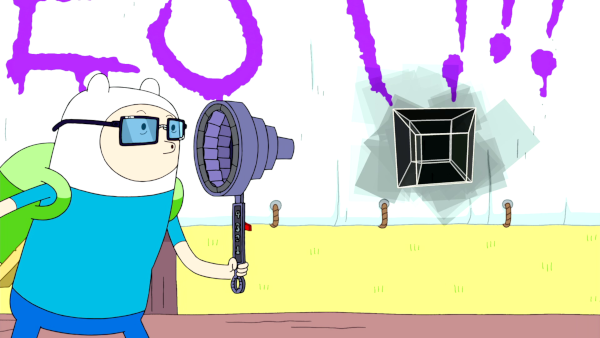
Rather than explore the implications of this idea, this episode involves Finn making a machine that blows bubbles at various dimensionalities, which is a neat way to introduce kids to spheres of different dimensions. First: a 2D bubble (1-sphere, or circle - except here it’s filled in, making it a 2-ball rather than 1-sphere) with a 1D shadow (a nice way to express projection; here it’s a 1-ball, aka line segment); then, a 3D bubble (2-sphere) with a 2D shadow (2-ball, or disk). Unfortunately they spoil it when it’s time to make a 3-sphere and project it into a 3-ball. Instead, they show a projection of a tesseract (4-cube) in the process of being rotated, surrounded by a cloud of black squares. I guess the actual 3-sphere was considered too hard to show? But they could totally have shown something similar with gridlines on the projection of a rotating 3-sphere!
For reasons that are kind of left vague, this tesseract bubble turns into a black hole - but one which conveniently remains levitating above the ground instead of falling into the centre of Ooo.
As far as the plot is concerned, ‘smart’ Finn manages to communicate the romantic interest he can’t admit to Princess Bubblegum, and she kisses him. Clearly I’ve spent too many words on this one episode, but let’s talk about that.
Like, the obvious issue here is that, Finn’s a fuckin twelve-year-old, and PB is a thousands-year-old candy elemental or something. Though, I believe at this point in the show, that had yet to be decided; Princess Bubblegum certainly acts pretty childlike in some ways. Perhaps that will be addressed later? Anyway she kisses him on the cheek and he fucking faints(!), then she giggles about it.
I remember they eventually abandon the Finn/PB romance angle in order to set Finn up with Flame Princess. PB’s interest in Finn feels almost like a troll in this episode - her view of Finn is kinda condescending/curiosity?
I realise that, as a lesbian, I may not be very good at working out what’s attractive about boys, but like, he’s a kid! A likeable kid, but still, a kid, with very immature ideas (or lack of them) about romantic relationships. This plotline is therefore quite uncomfortable.
Episode 16: Guardians of Sunshine
At least nominally a BMO episode, but still BMO doesn’t seem to have much of a character beyond ‘walking games console’. It’s a very generic ‘sucked into a computer game’ plot, and it feels like the writers don’t actually play games. The whole plot is very paint by numbers: you can predict almost everything that happens from the opening minutes. One of Adventure Time’s greatest strength is that you can’t predict what wild shit they’re gonna show you next, so that’s kind of disappointing.
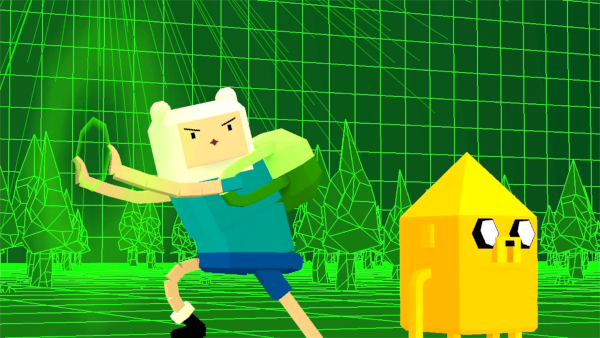
The most notable thing about the episode is that the ‘inside BMO’ parts of the plot are animated in deliberately limited CGI - pseudo-PS1 graphics. It’s maybe the first time the show has experimented with style like this?
Episode 17: Death in Bloom
I was a little frustrated with the show, but this episode, things get back on form!
This is the first episode where it’s really spelled out that Peppermint Butler is some kind of undead necromancer.
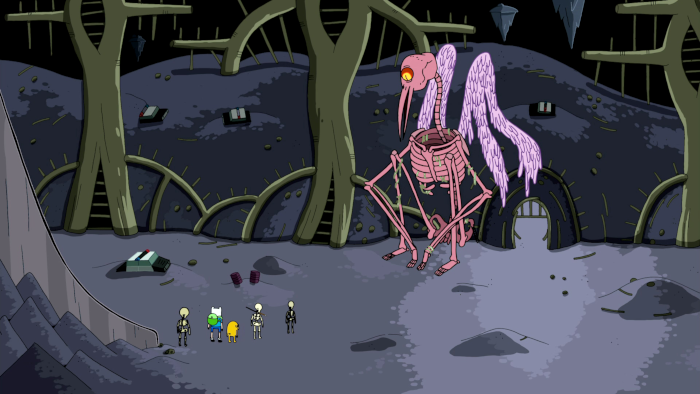
Finn and Jake are tasked with guarding a ‘princess plant’; they fail in an amazingly ridiculous montage of treating it like a human kid. So they decide they must go to the land of the dead to save it! It’s such a good premise and it’s pretty well realised, a decent play on all the ‘venturing to the underworld’.
I really enjoy the aesthetic lengths they go to in illustrating the land of the dead. Lots of references to metal as you’d expect, culminating in Death doing some classic metal growls while playing a music contest against Finn. The joke pacing in this episode also felt really solid. It all evolved according to logic that walked a narrow line between what you’d expect and totally surprising.
Episode 18: Susan Strong
Ahh, this was an episode I remember, and was looking forward to seeing again! This is where they first begin addressing that whole question of ‘is Finn the only human’. I think Susan was immediately a popular character with the fandom; she certainly shows up later a whole bunch.
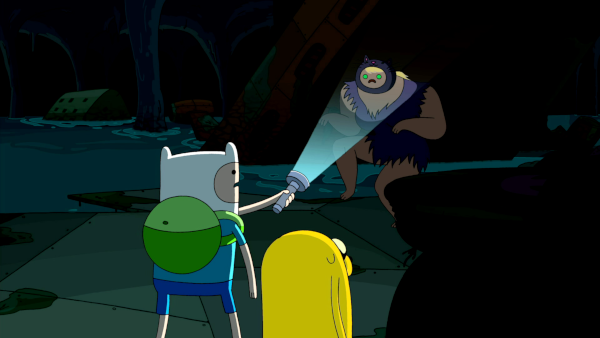
The implications raised by this episode are kind of weird. So far everyone has spoken the same language; the ‘feral’ ‘humans’ led by Susan speak nonsense words, but kind of rapidly learn English over the course of the episode. There’s a weird sort of contrast between post-apocalyptic mutant humans living in a sewer full of garbage, and the various ‘themed’ villages and cities on the surface.
Finn kind of weirdly concludes that people who are human except for like, fins (lol) on their head are not human? Even though I feel like these people blatantly were human.
One thing that’s kind of frustrating with Adventure Time’s depictions of its few humans characters is that they’re almost universally pale-skinned; often, more than that, implicitly white. Clearly the mostly white producers of the show just didn’t think about that at all, which is… not a great look! There are examples of racial coding in the non-human characters, most notably Cake, but we’ll get to that whenever that comes up.
Rewatching, this episode was… OK. The bestial, feral humans are basically a big play on that rather troublesome post-apocalyptic ‘feral mutant’ trope, and much like the ‘island cannibal tribe’ of the European colonial imagination before them, they fear innocuous things, struggle with language, are amazed by the commodities of ‘civilisation’ such as marshmallows and candy, and violent in that they decide to devour the Candy People. Later on I believe they will be fleshed out a lot more.
Episode 19: Mystery Train
It’s Finn’s birthday, so I believe he is now 13 years old. I believe they more or less tried to age Finn along with the show, roughly one year per season, though whether they stuck too strictly to that as the schedule got kind of weird, I’m not sure.
Jake and a bunch of candy people stage a murder mystery on a train for Finn. It’s a parody of Murder on the Orient Express; mostly the jokes are of the ‘isn’t this zany’ variety, so it’s not that satisfying.
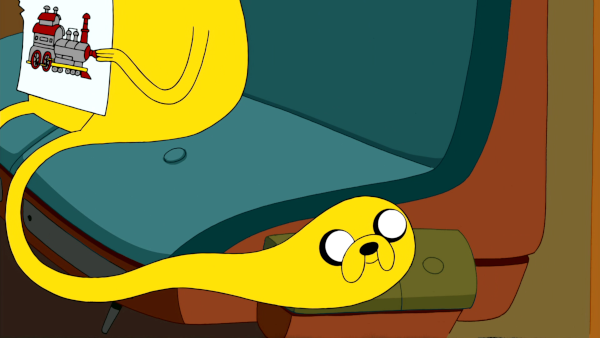
Jake using his fleshwarping powers to create the appearance of an entire separate moving person is pretty funny though. I do really enjoy when they run with that element.
Episode 20: Go With Me
For an episode focusing on Finn’s difficulties with romance, this episode is waaay better than you’d imagine! There’s a couple of reasons: Marceline is amazing as always, and there’s already grounds for a ‘PB and Marceline are exes’ reading. Also the wolves were really good.
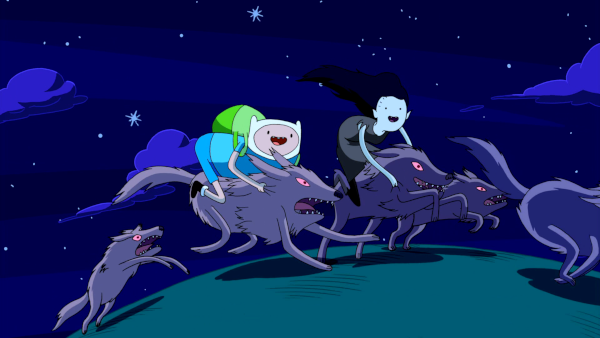
Why does Marceline go to such efforts to sabotage Finn’s attempts to get with PB? Of course she would know that wrestling her, or putting wolves in her bedroom, are not things she wants. Why does PB glare at Marceline when she sees her, how does Marceline know PB’s name is Bonnibel? It’s certainly not text, or representation or anything, but my reading is that Marceline got involved precisely because she’s still got feelings for Bonnibel.
Finn, being a thirteen-year-old, doesn’t actually want to make out with a girl at the movies, just see the movie; this is the wacky misunderstanding that underlies the episode. Jake was the one pushing him to approach it romantically. But, it works well enough.
The wolf bit was amazing!
Episode 21: Belly of the Beast
For some reason, this is one I remember.
This is actually not the first appearance of the ‘party bears’ - I noticed them before in S01E17 - but it is the first time they are named as such. This time, they’ve taken up residence in the stomach of a giant monster, conveniently not full of acid. The innards of the giant monster are some very cool biological environments that almost make you not notice that the monster is much bigger on the inside.
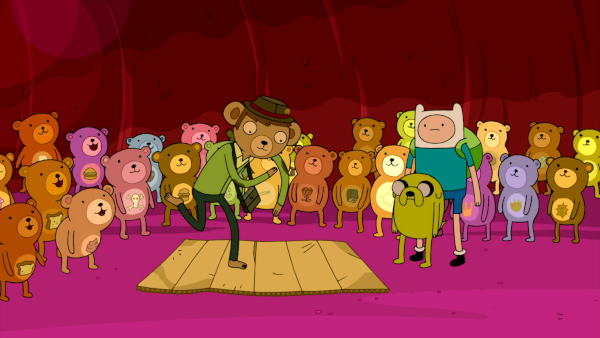
What kind of parties do the party bears hold? This is a strange situation, because the show is unable - as a cartoon which at least nominally includes kids as a major target audience - to explicitly refer to alchohol, even though it’s definitely more the kind of party that university students might have (I’m tempted to call it a rave! but I’m not exactly sure of the ‘rave demarcation problem’) than one a 13-year-old kid is like to have.
As far as not mentioning things goes… this episode is also very cagey about referring directly to ‘shit’, with euphemisms like… ‘the stuff’.
Anyway, the bears are led by ‘Party Pat’, who I feel like has got to be a parody of a specific person? Let’s check the wiki.
Party Pat’s appearance is based on Adventure Time creative director Patrick McHale. This is the second character created based on Pat; the others are Gingerbread Pat and Punsy McKale, a character in The Marvelous Misadventures of Flapjack.
Huh. Well, that wasn’t quite what I was expecting.
As has become common, the resolution to the conflict of the episode is an unexpected non-resolution. I don’t know how the monster doesn’t like the sensation of fireworks, but can happily guzzle molten lava. But anyway.
This episode was… OK. I’m not exactly sure why it lodged in my memory!
Episode 22: The Limit
I really like this episode.
This is the first episode to really explore, fittingly, the limit of Jake’s near unlimited stretching power - by forcing him to stretch out through a labyrinth.
But also… just the whole…
-
Finn: What are you gonna wish for, dude?
-
Jake: Oh, you know, that something special only two bros can share…
-
Finn: (breathlessly) I think I’m wishing for the same thing!
-
Jake: You mean the…
-
both together: Ancient psychic tandem war-elephant!?
(which, admittedly, could be read as queerbaiting? but… holy shit that payoff!)
What’s even better is that the episode actually delivers on this wild premise and introduces the War Elephant as a character! It’s a perfect blend of weird but specific with its own internal logic, with a great image to boot.
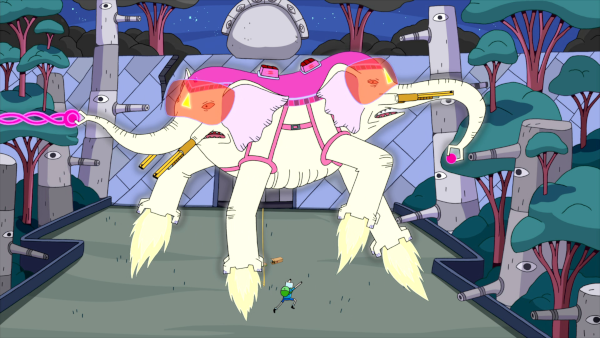
This episode just has some fantastically fucked up imagery all round, as Jake gets more and more distorted. But I don’t just like it bc body ‘horror’ is my thing. There’s some really funny moments of character humour too.
Since it’s created by a wish, I’m not sure if we’re supposed to conclude the Ancient Psychic Tandem War Elephant was ever developed in the setting’s history, or if it’s just a figment of Finn and Jake’s imagination given form. Whatever it is, it occasionally shows up again later on. In fact apparently it’s going to get an entire episode down the line.
Episode 23: Video Makers
This episode is a mite predictable, though it is one of the few this season that alludes to the post-apocalyptic premise. I did enjoy the gag where they decide they have to obey copyright notices.
BMO is getting a little more agency, which is nice. They ultimately help Finn and Jake reconcile over their creative differences in the filming.
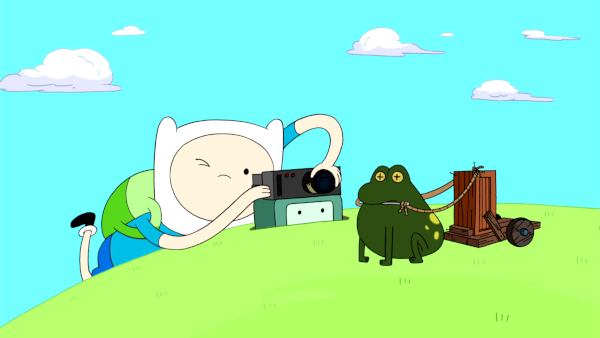
One thing I do find quite interesting is how Jake relates to gender. In various episodes, they’ve had Jake be the one volunteering to crossdress and it’s usually not played for ‘man in a dress’ gags, and generally being more comfortable with gender variance than Finn is. In this episode, Jake is the one who wants to make a romantic comedy, while Finn wants the kind of action movie a 13-year-old would want. I don’t know if it’s just that Jake is supposed to be more mature than Finn or what; I don’t think Jake is supposed to be read as a transfeminine character. This might be interesting to return to when we get to Fiona and Cake.
Episode 24: Heat Signature
Both episodes in this pair concern movies from the old world, which is interesting. In this episode, Marceline’s friends with some asshole ghosts, who take a prank on Finn and Jake and turn it into attempted murder. I always enjoy Marceline of course; and it’s getting at that tension in Marceline’s character between the way she grew up in the halloween-monster world of the Nightosphere, and the slightly more grounded world of Ooo (not a sentence I’d ever think I’d be writing). Still, the episode’s… OK.
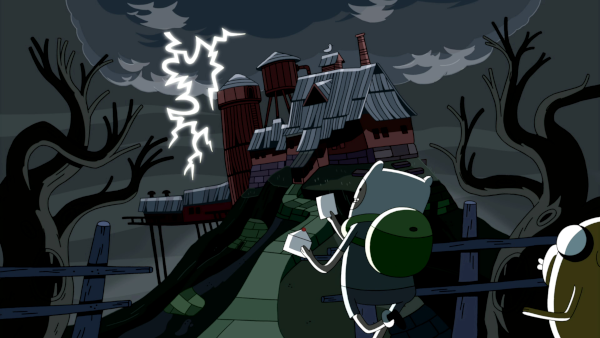
Naturally, the expected resolution - Marceline turning on her old friends to defend Finn and Jake - is subverted. Marceline isn’t actually going to intervene after she apologises for her prank, but the ghosts back off when they hear Finn and Jake have a submarine movie they want to watch.
I don’t think the jerk ghosts ever come back, which is a good thing really.
Oddly, in this episode, Finn and Jake are surprised to see LSP homeless, even though we’ve already seen that. I assume this is because the episodes were planned in a different order?
Episode 25: Mortal Folly
The last season ended rather abruptly with a very ordinary episode. This season, they begin the pattern of ending (and soon, beginning) each season with dramatic, multi-part episodes! So this time, the stakes are much much higher.
We briefly saw the Lich (then, Lich-King) towards the end of the last season, but it would be easy to think he didn’t matter. But here, he comes into his own as the overall villain of the next several seasons! We don’t know much about him yet, apart from his ability to possess people and the existential threat he poses.
The Ice King is there to be ineffectual, I guess, and provide contrast: the Lich is entirely efficient malevolence while the Ice King continues to be a massive dork.
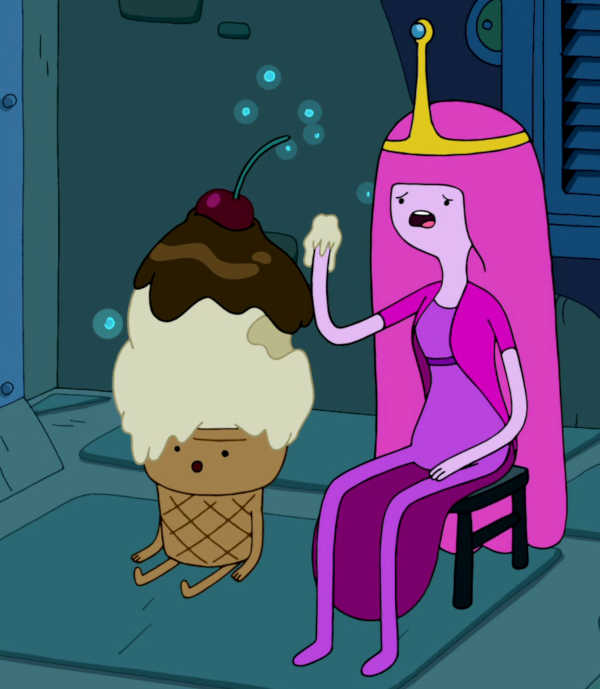
Anyway, apart from the high stakes, the other major thing is that the Lich is (temporarily defeated) by the power of ‘lll… ll… ll… liking someone a lot’, as physically embodied in the sweater that PB gives Finn. This is marking that they’re about to try and put Finn and PB together, but their relationship in this episode their relationship basically feels more maternal on PB’s side; it’s kind of uncomfortable. (Though, when we see how they address this…)
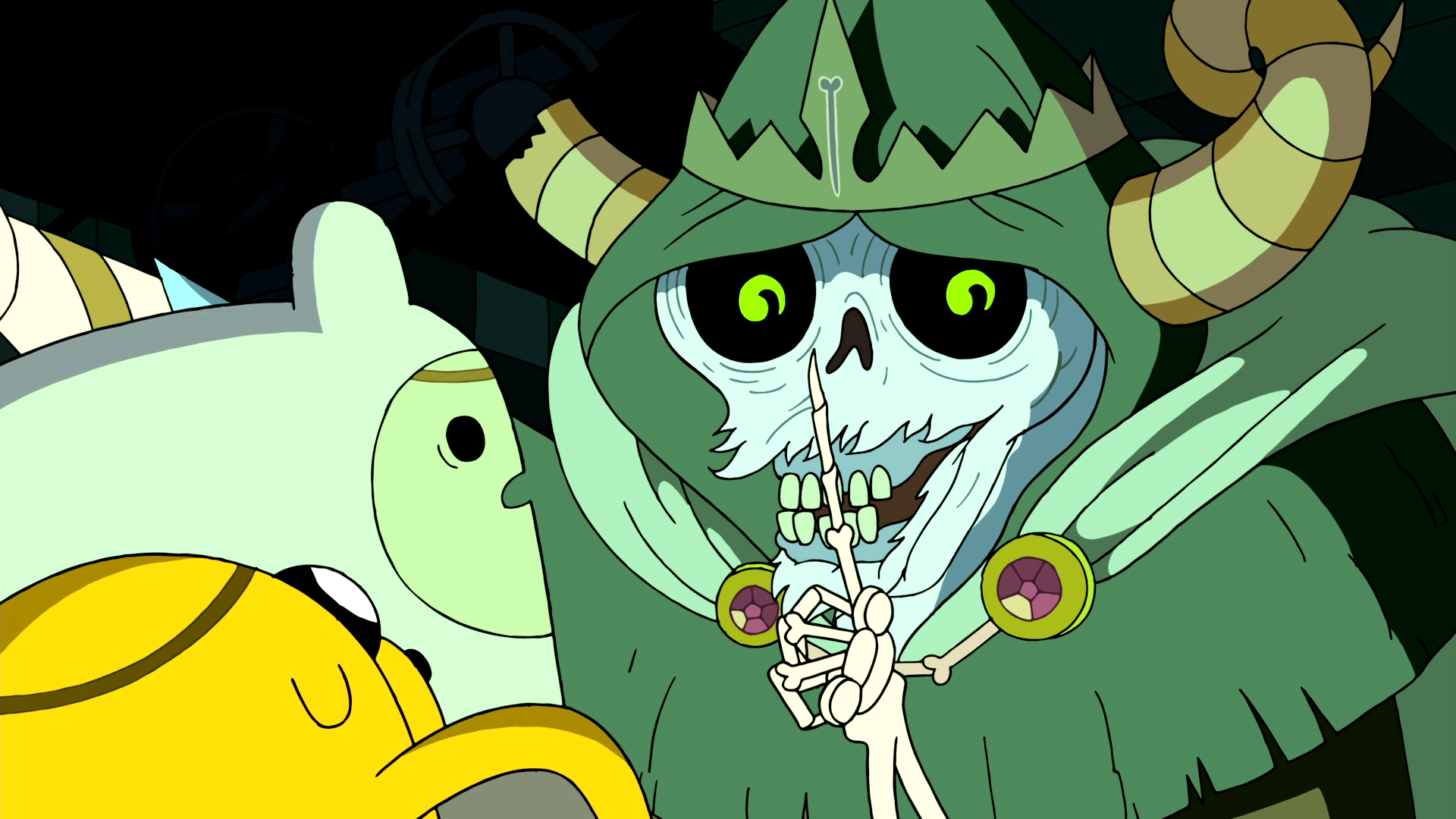
The design of the Lich is pretty cool - a lot more detailed and grisly than most Adventure Time characters. He’s got like, no skin on his jaw or arms! Plus that weird semi-cow-skull thing…
Anyway at the end of this episode, PB is dropped in toxic lich sludge! (Which I guess they never did anything about because, uh…) I believe this is the first time an episode has directly followed from the end of another like this, and it brings us to…
Episode 26: Mortal Recoil
So PB is possessed by the Lich, and everyone takes a while to realise it.
I do enjoy seeing Doctor Ice Cream and Doctor Princess working, incongruously, together. This episode has plenty of wacky comedy, and there’s some really cool experimental camera angles at points.
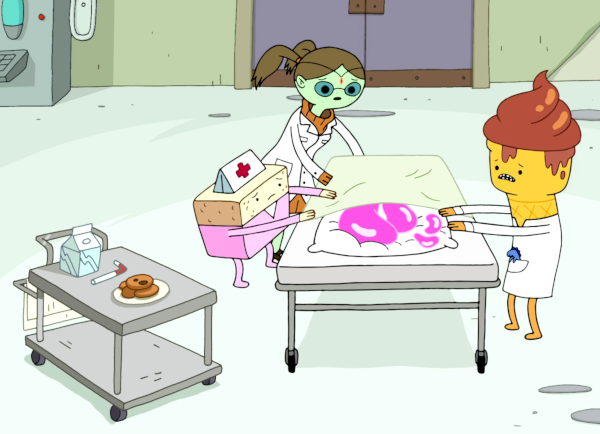
I’m not sure how I feel about the ‘hulked out’, ‘ugly’ version of PB - her skin is darkened (yeah hmm), she’s all lumpy, but she’s still wearing a dress because imagine if!!! So you know, not really good. Or that they have the Ice King be so central to the episode. It’s the recurring problem of like, male characters’ stories being primary, even when that male character is being critiqued, you know?
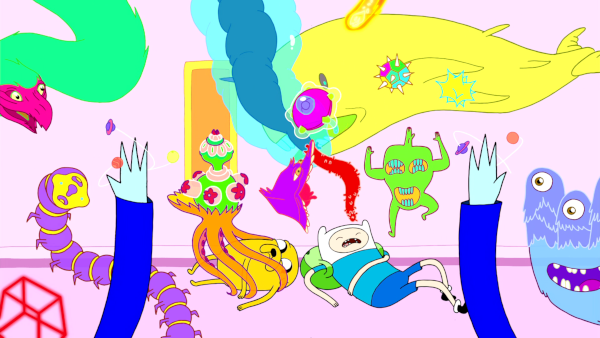
But anyway, the real big deal here is the dramatic character change they make - thankfully, not permanent. At the end of the episode, PB is frozen by the Ice King, and shattered! It’s a surprisingly gory moment - you can see bones inside her. Fortunately, since she’s literally made of bubblegum, she can be stuck back together… but there’s missing bubblegum, so she ends up not as the adult science dork we all love, but a 13 year old.
Which is to say, a conveniently romanceable age for Finn.
I don’t really like this plotline. I can’t remember how long this takes; ultimately they abandon the Finn/PB romance angle and the show is better for it. (It’s kind of unusual in a way for a cartoon like this that the protagonist goes through a variety of love interests.) But we’re going to have to see a few episodes where PB is age regressed. How shocking, etc.
Season 2
So, Season 2 of Adventure Time! That had… ups and downs.
The positive signs are that they’re already starting to experiment with longer-form plots, and the snowballing callbacks to previous weird shit (fun but unsatisfying) that makes it turn into weirdly consistent shit (that’s the good shit).
The bad sign is the dreadful handling of gender. In fact, a lot of that comes in one particular writer’s episodes. To be fair on Kent Osborne, his later episodes in the season - Mystery Train, Belly of the Beast and Video Makers are considerably better. They are, admittedly, also mostly about men.
I’m surprised how long it’s taken to develop BMO’s character beyond the basic point of ‘talking computer’, though there was a little of that in Video Makers!
If there is a major arc over the course of this season, it is about the development of Finn’s attitude towards romantic relationships. Or to a fair extent, lack thereof - he’s still pretty uncomfortable with the idea by the end of the season. Episodes endlessly toy with pushing Finn into dealing with romantic advances and his own suppressed feelings, even though he’d rather punch people. It’s a dynamic that gets pretty old pretty fast.
It does seem like a Finn/PB romance was being ‘built towards’ at this stage; perhaps because, in the show’s original premise and pilot, Finn/PB was considered a core part. Princess Bubblegum, however, will refuse to be reduced to a love interest character and develop into a very unusual and interesting figure for a cartoon like this one. At some point, the writers are going to realise that Finn/PB just isn’t on the cards, and write Flame Princess into the story to take the “Finn’s love interest” role - only to ultimately follow a similar couse to PB!
There is something to be said for depicting romantic relationships that don’t work out permanently as a route into marriage, kids etc. in a kids’ show. Of course like, nearly every relationship everyone ever enters into will ultimately be a temporary one, and that’s all right. The standard in cartoons tends to be ‘romantic tension leading into Endgame Pairing’, with the outcome treated as being very final - and this is fertile ground for ‘shipping wars’ and the like that build engagement with a show. So, on one level, I’m glad that Adventure Time is showing Finn growing and maturing and his relationships to people changing; showing that he can still be friends with people after their romantic relationship has ended.
At the same time, I think this dynamic is handled considerably better with Flame Princess than it was with PB. The de-aging at the end of this season feels really transparent, and honestly it’s hard to reconcile her fretting over Finn with the Machiavellian ruler she becomes in later seasons.
I think overall… while there’s signs of what made Adventure Time so good here, it feels very much like it’s still struggling to work out what it wants to do at this point, and following some routes that I think were probably mistakes in light of where they ended up taking it. That’s OK, though. We’ve got another eight seasons to go!
Comments